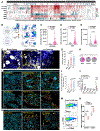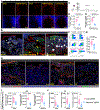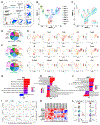Osteoprogenitor-GMP crosstalk underpins solid tumor-induced systemic immunosuppression and persists after tumor removal
- PMID: 37146584
- PMCID: PMC10165729
- DOI: 10.1016/j.stem.2023.04.005
Osteoprogenitor-GMP crosstalk underpins solid tumor-induced systemic immunosuppression and persists after tumor removal
Abstract
Remote tumors disrupt the bone marrow (BM) ecosystem (BME), eliciting the overproduction of BM-derived immunosuppressive cells. However, the underlying mechanisms remain poorly understood. Herein, we characterized breast and lung cancer-induced BME shifts pre- and post-tumor removal. Remote tumors progressively lead to osteoprogenitor (OP) expansion, hematopoietic stem cell dislocation, and CD41- granulocyte-monocyte progenitor (GMP) aggregation. The tumor-entrained BME is characterized by co-localization between CD41- GMPs and OPs. OP ablation abolishes this effect and diminishes abnormal myeloid overproduction. Mechanistically, HTRA1 carried by tumor-derived small extracellular vesicles upregulates MMP-13 in OPs, which in turn induces the alterations in the hematopoietic program. Importantly, these effects persist post-surgery and continue to impair anti-tumor immunity. Conditional knockout or inhibition of MMP-13 accelerates immune reinstatement and restores the efficacies of immunotherapies. Therefore, tumor-induced systemic effects are initiated by OP-GMP crosstalk that outlasts tumor burden, and additional treatment is required to reverse these effects for optimal therapeutic efficacy.
Keywords: MDSCs; bone marrow niches; cancer; hematopoiesis; hematopoietic stem/progenitor cells; immunotherapies; myelopoiesis; osteoprogenitor; scRNA-seq; systemic immunosuppression.
Copyright © 2023 Elsevier Inc. All rights reserved.
Conflict of interest statement
Declaration of interests The authors declare no competing interests.
Figures







References
-
- Peinado H, Aleckovic M, Lavotshkin S, Matei I, Costa-Silva B, Moreno-Bueno G, Hergueta-Redondo M, Williams C, Garcia-Santos G, Ghajar C, et al. (2012). Melanoma exosomes educate bone marrow progenitor cells toward a pro-metastatic phenotype through MET. Nat Med 18, 883–891. 10.1038/nm.2753. - DOI - PMC - PubMed
Publication types
MeSH terms
Substances
Grants and funding
- T32 GM152777/GM/NIGMS NIH HHS/United States
- S10 OD023469/OD/NIH HHS/United States
- R25 GM056929/GM/NIGMS NIH HHS/United States
- S10 RR024574/RR/NCRR NIH HHS/United States
- F31 CA281063/CA/NCI NIH HHS/United States
- P50 CA186784/CA/NCI NIH HHS/United States
- S10 OD025240/OD/NIH HHS/United States
- R01 CA204191/CA/NCI NIH HHS/United States
- P30 CA125123/CA/NCI NIH HHS/United States
- U01 CA253553/CA/NCI NIH HHS/United States
- R01 CA221946/CA/NCI NIH HHS/United States
- P30 EY002520/EY/NEI NIH HHS/United States
- R01 CA251950/CA/NCI NIH HHS/United States
- R01 CA183878/CA/NCI NIH HHS/United States
- R01 CA227904/CA/NCI NIH HHS/United States
LinkOut - more resources
Full Text Sources
Medical
Molecular Biology Databases
Miscellaneous

